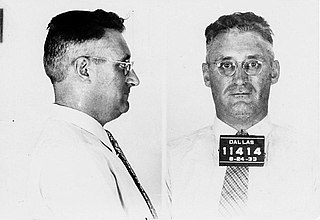 W
WHarvey John Bailey, called "The Dean of American Bank Robbers", had a long criminal career. He was one of the most successful bank robbers during the 1920s, walking off with over $1 million.
 W
WBasil Hugh "The Owl" Banghart Jr. was an American criminal, burglar and prison escape artist. Although a successful "stickup artist" during the 1920s and early 1930s, he is best remembered for his involvement in the hoax kidnapping of Chicago mobster Jake "The Barber" Factor, a crime for which he and Roger Touhy were eventually proven innocent after nearly 20 years in prison.
 W
WThe Barker–Karpis Gang was one of the longest-lived criminal gangs during the Depression Era, spanning from 1931 to 1935. The gang was founded by Fred Barker and Alvin Karpis, and later joined by Fred's brother Arthur "Doc" Barker. Along with the three core members, the gang's network spanned up to 25 members at one point.
 W
WArthur R. Barker was an American criminal, the son of Ma Barker and a member of the Barker-Karpis gang, founded by his brother Fred Barker and Alvin Karpis. Generally known as "Doc", Barker was typically called on for violent action, while Fred and Karpis planned the gang's crimes. He was arrested and convicted of kidnapping in 1935. Sent to Alcatraz Federal Penitentiary in 1936, he was killed three years later while attempting to escape from the Rock.
 W
WFrederick George Barker was an American criminal who, along with Alvin Karpis, co-founded the Barker-Karpis gang, which committed numerous robberies, murders and kidnappings during the 1930s. Barker was the youngest son of Ma Barker, all of whose children were criminals. He was killed in a lengthy gunfight with the Federal Bureau of Investigation (FBI) in 1935.
 W
WKate Barker, better known as Ma Barker and sometimes as Arizona Barker as well as Arrie Barker, was the mother of several American criminals who ran the Barker-Karpis gang during the "public enemy era" when the exploits of gangs of criminals in the Midwest gripped the American people and press. She traveled with her sons during their criminal careers.
 W
WBlanche Barrow was the wife of the elder brother of Clyde Barrow, known as Buck. He became her second husband after his release from prison after a pardon. To her dismay, he joined his brother's gang. Blanche was present at the shootout which resulted in them becoming nationally recognized fugitives. She spent four months with the Bonnie and Clyde gang. Although she never used a gun, she was blinded in one eye during a getaway. In the same incident, she rescued her husband under heavy police gunfire. She was caught along with her fatally wounded husband by a posse of local men in Iowa. She served six years in prison for assault with intent to kill the sheriff of Platte County, Missouri, but was treated sympathetically by him. After her release, she remarried and lived quietly thereafter. Barrow was extensively consulted for the fictionalized 1967 film about the Barrow gang, but disliked her portrayal in it.
 W
WMarvin Ivan "Buck" Barrow was a member of the Barrow Gang. He was the older brother of the gang's leader, Clyde Barrow. He and his wife Blanche were wounded in a gun battle with police four months after they joined up with Bonnie and Clyde. Buck died of his injuries soon afterwards.
 W
WAlbert Lawrence Bates was an American bank robber and burglar during the 1920s and 1930s. He used a number of different aliases during his criminal career including George Davis, George Harris and J.B. King. He was the longtime partner of George "Machine Gun" Kelly. He also took part in the kidnapping of oil magnate Charles Urschel in July of 1933.
 W
WEdward Wilhelm Bentz was an American bank robber and Depression-era outlaw. He was associated with several high-profile public enemies during his criminal career, including Harvey Bailey, Albert Bates, George "Machine Gun" Kelly and Baby Face Nelson. He was eventually captured by the FBI and sentenced to Alcatraz.
 W
WBonnie Elizabeth Parker and Clyde Chestnut Barrow were an American criminal couple who traveled the Central United States with their gang during the Great Depression, known for their bank robberies, although they preferred to rob small stores or rural gas stations. Their exploits captured the attention of the American press and its readership during what is occasionally referred to as the "public enemy era" between 1931 and 1934. They are believed to have murdered at least nine police officers and four civilians. They were killed in May 1934 during an ambush by police near Gibsland, Louisiana.
 W
WFred William Bowerman was an American bank robber and Depression-era outlaw. A veteran holdup man, his criminal career lasted over 30 years and he was placed on the FBI's "Ten Most Wanted" list in 1953. That same year, his last, Bowerman organized and led the disastrous Southwest Bank holdup in St. Louis, Missouri, which resulted in a standoff between himself and his three partners against a force of over 100 officers of the St. Louis Police Department. The events were later made into a film, The Great St. Louis Bank Robbery (1959), starring Crahan Denton and Steve McQueen.
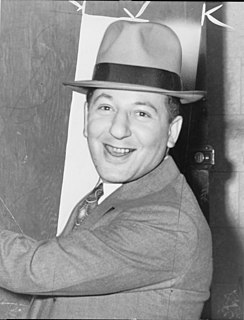 W
WLouis Buchalter, known as Louis Lepke or Lepke Buchalter, was an American mobster and head of the Mafia hit squad Murder, Inc. during the 1930s. Buchalter was one of the premier labor racketeers in New York City during that era.
 W
WThomas Leonard "Tommy" Carroll was an American bank robber and Depression-era outlaw. A boxer-turned-criminal, he committed numerous robberies during the 1920s and 1930s as well as being a longtime member of the Dillinger gang.
 W
WJohn Paul Chase was an American bank robber and Depression-era outlaw. He was a longtime criminal associate of the Karpis-Barker Gang and most notably Baby Face Nelson who later brought him into the John Dillinger gang. FBI Director J. Edgar Hoover once referred to Chase as "a rat with a patriotic-sounding name". Chase and Nelson continued to rob banks with John Dillinger until Dillinger's death in July 1934. After the death of Nelson in November 1934, Chase fled back to California where he was arrested a month later on December 27, 1934. Chase was sent to Alcatraz where he became one of the longest-serving inmates;.
 W
WRussell Lee "Boobie" Clark was an American thief, bank robber and prison escapee. He is best known as the "good natured" member of the John Dillinger gang and participated in armed holdups with them in a three-month crime spree across the Midwestern United States from October 1933 until his capture in January 1934.
 W
WFrancis "Two Gun" Crowley was an American murderer. His crime spree lasted nearly three months, ending in a two-hour shootout with the New York City Police Department on May 7, 1931, that was witnessed by 15,000 bystanders and received national attention. He became the archetype of the Irish gangster. In 1932 he was executed in New York's electric chair.
 W
WVolney Everett "Curley" Davis was an American bank robber and Depression-era outlaw. A longtime Oklahoma bandit, he was the boyfriend of Edna Murray and an associate of both the John Dillinger and Alvin Karpis-Barker gangs during the 1930s.
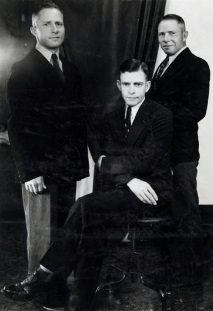 W
WThe DeAutremont Brothers, Roy, Ray and Hugh DeAutremont, were a criminal gang based in the Pacific Northwest during the 1920s. Their unsuccessful robbery of Southern Pacific Railroad express train and the murder of four crew members, known as the Siskiyou massacre, was subject to one of the largest and most extensive investigations in the region.
 W
WJohn Herbert Dillinger was an American gangster of the Great Depression. He led a group known as the "Dillinger Gang" which was accused of robbing 24 banks and 4 police stations. Dillinger escaped from jail twice. He was charged but not convicted of the murder of an East Chicago, Indiana, police officer who shot Dillinger in his bullet-proof vest during a shootout. It was the only time Dillinger was charged with homicide.
 W
WHerbert Allen Farmer, was an American criminal who, with his wife Esther, operated a safe house for underworld fugitives from the mid-1920s to 1933.
 W
WCharles Arthur Floyd, nicknamed Pretty Boy Floyd, was an American bank robber. He operated in the West and Central states, and his criminal exploits gained widespread press coverage in the 1930s. He was seen positively by the public because during robberies he burned mortgage documents freeing many people from their debts. He was pursued and killed by a group of Bureau of Investigation (BOI) agents led by Melvin Purvis. Historians have speculated as to which officers were at the event, but accounts document that local officers Robert "Pete" Pyle and George Curran were present at his fatal shooting and also at his embalming. Floyd has continued to be a familiar figure in American popular culture, sometimes seen as notorious, other times portrayed as a tragic figure, even a victim of the hard times of the Great Depression in the United States.
 W
WBuda Godman (née Helen Julia Godman; December 4, 1888 – January 7, 1945) was an American criminal, actress, and singer. From 1907 to 1910, she was married to the popular songwriter and music publisher Tell Taylor. Six years after Taylor divorced her, Godman was arrested and released on bail for participating in a scheme to blackmail a wealthy widower. Godman attempted a scheme known as a "badger game," which involved framing a victim in an embarrassing and illegal situation that resulted in a staged arrest by fake law enforcement officials. Godman posed as an unmarried woman being held against her will in a hotel room across state lines, which, if true, would have been a violation of the Mann Act. The ensuing fake arrest went awry when the victim reported the incident to authorities.
 W
WHarold Eugene "Eddie" Green was an American bank robber and Depression-era outlaw during the 1930s, best known as a member of the John Dillinger gang. He was also associated with Frank "Jelly" Nash, Volney Davis and the Barker-Karpis Gang in his early career.
 W
WJohn "Red" Hamilton was a Canadian criminal and bank robber active in the 1920s–1930s, most notably as an associate of John Dillinger. He is best known for his lingering death and secret burial after being mortally wounded during a robbery.
 W
WWilliam Daniel Jones was a member of the Barrow Gang, whose spree throughout the southern Midwest in the early years of the Great Depression became part of American criminal folklore. Jones ran with Clyde Barrow and Bonnie Parker for eight and a half months, from Christmas Eve 1932 to early September 1933. He and another gang member named Henry Methvin were consolidated into the "C.W. Moss" character in the film Bonnie and Clyde (1967). "Moss was a dumb kid who run errands and done what Clyde told him," Jones later said. "That was me, all right."
 W
WAlvin Francis Karpis, a Depression-era gangster nicknamed "Creepy" for his sinister smile and called "Ray" by his gang members, was a Canadian-born criminal of Lithuanian descent known for being a leader of the Barker–Karpis gang in the 1930s. Karpis led the gang along with Fred Barker and Arthur "Doc" Barker. There were only four "public enemies" ever given the title of "Public Enemy #1" by the FBI and he was the only one to be taken alive. The other three, John Dillinger, Pretty Boy Floyd, and Baby Face Nelson, were all killed before being captured. He also spent the longest time as a federal prisoner at Alcatraz Federal Penitentiary, serving twenty-six years.
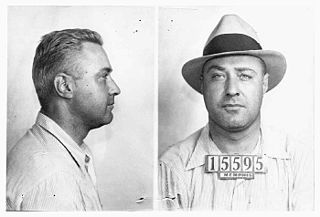 W
WGeorge Kelly Barnes, better known by his nickname "Machine Gun Kelly", was an American gangster from Memphis, Tennessee, during the prohibition era. His nickname came from his favorite weapon, a Thompson submachine gun. He is best known for the kidnapping of the oil tycoon and businessman Charles F. Urschel in July 1933, from which he and his gang collected a $200,000 ransom. Urschel had collected and left considerable evidence that assisted the subsequent FBI investigation, which eventually led to Kelly's arrest in Memphis, Tennessee, on September 26, 1933. His crimes also included bootlegging and armed robbery.
 W
WJohn Allen Kendrick was an American criminal, escape artist, bank robber and member of the Tri-State Gang whose career spanned four decades. He was listed on the FBI's Top Ten Most Wanted in late 1955, and was apprehended by the FBI that same year.
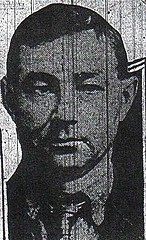 W
WHerman Karl Lamm, known as Baron Lamm, was a German-American bank robber. His robberies paid close attention to detail of the target properties, and he has been described as "the father of modern bank robbery". A former Prussian Army soldier who immigrated to the United States, Lamm believed a heist required all the planning of a military operation. He pioneered the concepts of "casing" a bank and developing escape routes before conducting the robbery. Using a meticulous planning system called "The Lamm Technique", he conducted dozens of successful bank robberies from the end of World War I.
 W
WCharles Omer Makley, also known as Charles McGray and Fat Charles, was an American criminal and bank robber active in the early 20th century, most notably as a criminal associate of John Dillinger.
 W
WVernon C. Miller was a freelance Prohibition gunman, bootlegger, bank robber and former sheriff in Huron, South Dakota, who, as the only identified gunman in the Kansas City massacre, was found beaten and strangled to death shortly after the incident.
 W
WLester Joseph Gillis, known by the alias George Nelson and Baby Face Nelson, was an American bank robber. He became partners with John Dillinger, helping him escape from prison in Crown Point, Indiana. Nelson and the remaining gang members were labeled as public enemy number one. He was given the nickname Baby Face Nelson due to his small stature and somewhat youthful appearance, although few dared call him that to his face. Criminal associates instead called him "Jimmy".
 W
WHarry "Pete" Pierpont was a Prohibition era gangster. He is perhaps most noted for being a friend and mentor of John Dillinger.
 W
WAdam "Eddie" Richetti was an American criminal and Depression-era bank robber. He was associated with Aussie Elliott and later Pretty Boy Floyd in the early-1930s, both he and Floyd later being implicated in the Kansas City Massacre in 1933.
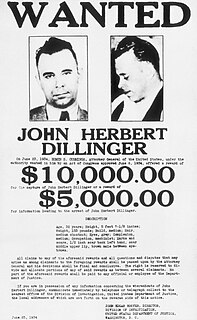 W
WThe Dillinger Gang was the name given to a group of American Depression-era bank robbers led by John Dillinger. The gang gained notoriety for a successful string of bank robberies, using modern tools and tactics, in the Midwestern United States from September 1933 to July 1934. During this crime spree, the gang killed 10 and wounded 7. They managed to pull off three jail breaks which wounded two guards and killed a sheriff.
 W
WHomer Virgil Van Meter was an American criminal and bank robber active in the early 20th century, most notably as a criminal associate of John Dillinger and Baby Face Nelson.